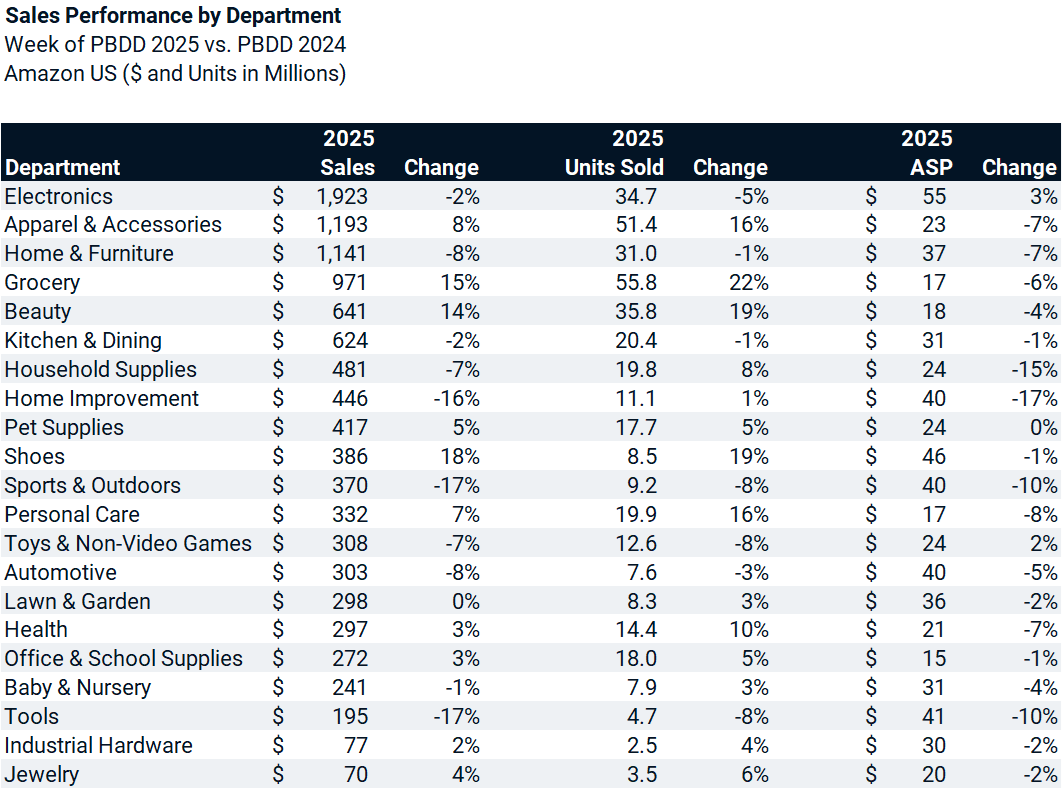With Amazon’s October 7th & 8th Prime Big Deal Days (PBDD) event now serving as the unofficial start to holiday shopping, Stackline dug into event-week performance and what this signals for year-to-go.
This year’s PBDD event drove $11 billion in event-week U.S. sales, though down slightly (-0.4%) compared to last year’s PBDD event. That’s coming off a record-breaking July Prime Day, which generated $15.2 billion in event-week retail sales in the U.S. (+10.3% YOY), and overall strong year-to-date performance on Amazon US (+8.0% YOY).
Unpacking the drivers and drainers of PBDD performance:
- Shoppers flocked to the retailer: During the week of PBDD 2025, Amazon US search volume was up +10.5% compared to PBDD 2024. Grocery (+37.9%) and Beauty (+33.0%) saw the largest department-level increases in search volume.
- Average Sell Prices (ASPs) fell across the board: In every major department except Electronics, ASPs were down compared to last year’s October Prime event. Household Supplies (-14.6%) and Home Improvement (-17.1%) saw double digit ASP declines.
- Strong event-week unit growth: While decreasing ASPs led to muted top-line sales for the event, unit volume increased in 8 of 12 major departments compared to PBDD 2024. Grocery was the largest unit gainer at +21.8% YOY.
- Billion-dollar departments: Electronics sales slipped -2.0% compared to PBDD 2024 but still generated nearly $2 billion in event-week volume. The Apparel & Accessories and Home & Furniture Departments each eclipsed the billion-dollar event-week mark.

What does this say about the U.S. consumer?
This year’s PBDD arrived amidst significant macroeconomic uncertainty, but consumption remains strong - especially in core categories. On the back of Amazon’s August announcement to expand same-day perishable delivery to over 1,000 cities in the U.S., the Grocery department (+14.6%) saw one of the largest top-line sales increases year-over-year. And while the Household Supplies department didn’t drive as much pantry stocking as during last year’s event, unit increases remained strong (+8.5%) even as shoppers exhibited significant trade down behavior (ASPs in Household Supplies fell sharply). This was largely in line with our pre-PBDD consumer research, which found that 39% of consumers were using PBDD to “stock up on the basics” (the highest incidence occasion).
Outside of Sports & Outdoors and Home Improvement, high involvement categories like Electronics (-2.0% on $1.9 billion in sales) and Beauty (+14.0%) performed quite well. Beauty, in particular, was a likely beneficiary of increased site-wide search volume and impulse purchasing. Pre-event, 32% of US shoppers indicated they planned to just browse the event, with no specific occasion in mind.
So what can brands do to prepare for year-to-go? While most plans for holiday are already well-laid, there’s still time to fine-tune activation strategies and drive strong holiday performance.
- Re-forecast event performance: Now that PBDD results are in, revisit your rest-of-holiday forecasts using the latest category and consumer data. Many brands will need to recalibrate based on price compression and shifting traffic trends. Stackline Beacon enables teams to forecast dynamically using AI-powered predictive models, real-time market data, and configurable inputs. With updated forecasts, brands can identify where to reallocate media or trade investments to offset potential holiday softness.
- Optimize visibility before key events: Pre-event behavior matters. Stackline’s pre-PBDD survey found that 65% of shoppers were building baskets in advance of the event. That means your brand’s visibility in the two weeks leading up to major shopping moments can make or break event-week sales. While this is the time of year where efficiency matters more than ever, ensure you’re well positioned within the mid-funnel to drive consideration throughout holiday.
- Win the shelf through data-driven execution: Lower ASPs and higher PBDD unit sales signal that value messaging and discoverability remain critical levers. Use Stackline Atlas to analyze gaps in pricing and share of voice – to ensure that you’re present and competitive for the must-win parts of your catalog.
- Invest in post-event retargeting: With 32% of shoppers browsing a major event like PBDD without a specific goal, this presents a major opportunity for post-event conversion heading into holiday. Retargeting shoppers who viewed or added products (but didn’t purchase) during PBDD can drive incremental gains heading into Black Friday and the rest of the Turkey 12 period. Stackline’s DSP and AMC experts are here to help fine tune your targeting strategies.






